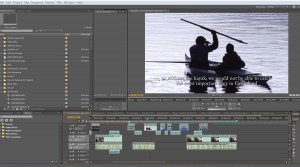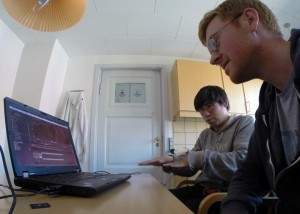Engaged Anthropology Grant: Matthew Walls

Matthew Walls is SSHRC Postdoctoral Fellow in Arctic Archaeology at the University of Oxford’s Institute of Archaeology, and a recipient of the Engaged Anthropology Grant. In 2011, while a doctoral student at the University of Toronto, he received a Dissertation Fieldwork Grant to aid research on “Frozen Landscapes, Fluid Technologies: Inuit Kayak Hunting and the Perception of the Environment in Greenland,” supervised by Dr. Max Friesen.
“To me, it makes sense, and the meaning is there” one participant tells me, after reviewing a sequence of footage we have been working on (above). The scene we were watching is from 2010, and it shows him teaching harpoon throwing. This was is a typical moment in my engagement project, this summer, and we were in the final stage of editing a documentary film on Inuit kayaking. Using video clips from my doctoral project, the idea is to adapt my research and co-produce something of value to the community. It has been in production since 2011, and the Engaged Anthropology Grant allowed me to return to the towns of Ilulissat and Sisimiut in order to ensure that participants can hear their own voices in the final cut by opening the editing process to them.
The community I worked with, from 2009-2011, build kayaks and practice traditional skills as a way of exploring Inuit heritage. Specifically, they find meaning in the persistence of kayaking because the physicality of the skill involves forms of cultural and environmental knowledge that can exist only through practice. As an archaeologist, I was interested in the theoretical implications this idea has for understanding the relationship between people and materials through time. I conducted three seasons of ethnoarchaeological fieldwork which documented the process through which Inuit become skilled kayakers. In my dissertation, I argued that understanding how sensorimotor knowledge is constructed between generations allows for archaeological narratives that better emphasize the agency of skilled practice through time.

As a partnership project, it was important for the community to have a voice in interpretation, and to produce materials they find meaningful and accessible. The film was one of several initiatives[i] to accomplish this, and the idea was originally proposed by an Elder as a way of creating something that would be valuable to future generations. Visual media was a prominent part of the research methodology, and this resulted in many hours of footage from interviews, community events, kayak construction, and training which could be used with informed consent. However, as I discovered, editing a film is a matter of weaving image and sound to create a narrative that smoothly conveys an intelligible message to the viewer. A challenge in assembling the film from excerpts was to ensure this process of selection and arrangement did not change the context of what participants had said or demonstrated. To navigate this, the film has been in a process of community review – as sections of the film were edited and sequenced, I showed them to participants via online streaming, which gave them the opportunity to comment and make suggestions for how it should be adjusted. This was a very slow but tremendously useful process, and over distance, it was possible to create a rough cut of the film.
So the Engaged Anthropology Grant gave me the opportunity to complete this process of co-production in person. Returning to Greenland this summer allowed me to show participants an assembled rough cut, to open the editing process to them by demonstrating how the software works, and to make changes together. This resulted in a number of significant developments in the film, ranging from small matters of arrangement to selecting new scenes of kayaking practices to match narration. In one case, a participant opted to re-record an interview to better capture his meaning. Language is a very important feature of the film – it will be in Kalaallisut (Greenlandic) with English subtitles – and during the visit, I reviewed the translations with participants who speak English, who helped me to refine them.
Opening the editing process to the community was also a chance to help develop their capacity to produce their own films. Through participating in the project, several community members became interested in the process of filmmaking and the possibilities it offers them for exploring and preserving kayaking heritage. For example, two participants are now making a film that documents different construction techniques, and another wants to make his own instructional videos about emergency rolls. During the visit, I spent some time helping them to get started with learning Lightworks – an open source video editing program. Returning to Greenland was also an opportunity to archive project materials in local museums, renew personal ties, and discuss possibilities for future research projects.
There are now some small edits and formatting necessary to complete the film[ii]; when it is finished, the community will be able to stream it in Kalaallisut online, and copies will be given to the kayak clubs and local museums. I think that the finished film will achieve the goal of co-producing something with the community that will have value for future generations in Greenland. In reflecting on the project, it is interesting to see how important the film became as a way of doing the research. The collaboration and refinement it entailed was an important part of co-constructing an understanding of the knowledge involved in the skill. It was my first experience in creating a film, and I’m very excited to include it as a feature of future collaborations.
[i] Other initiatives included a new media project website in Kalaallisut and English (www.qajaq.utoronto.ca).
[ii] Sample scenes from the film can be viewed on the project website: http://www.qajaq.utoronto.ca/english_site/film_trailer/film_trailer.html